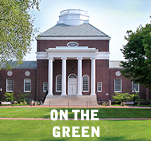
![]()

Students earn a shot at the pros

![]()

Students earn a shot at the pros
Three University students have been getting a shot with National Football League teams this summer, but instead of throwing spirals and popping pads, they’ve been taping and bracing.
Andrew Balick, Jonathan Boone and Derek Rivera of UD’s acclaimed athletic training education program, which is one of the oldest such programs in the nation, took part in NFL summer internships during which they worked with the world’s best football players through the rigors of training camp.
Balick, CHS ’07, worked with the Houston Texans; Boone, CHS ’08, with the defending National Football Conference champion Seattle Seahawks; and Rivera, CHS ’08, with the Buffalo Bills.
Thomas W. Kaminski, associate professor of health, nutrition and exercise sciences and director of athletic training education, says the selection of three students as NFL summer interns has been a coup for the program.
“It is tough enough for one student to get a summer internship opportunity in the National Football League, or any professional sport for that matter, let alone three,” Kaminski says. “This speaks loudly to the quality of student enrolled in the undergraduate athletic training education program at UD.”
Balick started with the Texans in July, taping players up before practice and overseeing stretching and exercises. And, under the hot Houston sun, he also provided liquids to make sure the players stayed hydrated through the course of practice.
Boone was doing a clinical rotation with the Fightin’ Blue Hens football team when John Smith, an assistant athletic trainer, informed him of the NFL opportunity and encouraged him to apply. He was thrilled to have been accepted, he says, because “working in the NFL is the top of the line as an athletic trainer.”
Boone’s primary contact with the Seahawks has been Donald Rich, who studied under Kaminski when the professor was at the University of Florida and who says interns handle taping and bracing, assist players with rehabilitation and help with daily treatments.
The fact that the Seahawks are coming off an NFC championship and a trip to the Super Bowl “is just an added bonus,” Boone says.
Rivera says that when he learned of the opportunity to join an NFL team, he “figured this would be a great experience, to work at a professional level.” He joined the Bills in July, assisting the team’s athletic trainers in the training room and at practices. He also was involved with field setup for practices.
“My background in the UD program has allowed me to grow as a student athletic trainer and build my skills, both in the classroom and in the athletic training room,” Balick says.
Boone says it has been especially helpful to work with the Fightin’ Blue Hens football team, where he was in charge of the general training room at the Delaware Field House and worked with athletes undergoing rehabilitation.
“Working with the football team has prepared me for the NFL just because I know what injuries to expect,” he says. “Football is a contact and high-impact sport, which means you see a lot of traumatic injuries.” A rash of UD injuries last season “allowed me to see more aggressive rehab procedures,” he adds.
Boone says that experiencing a variety of training procedure always is educational. “If you ask 10 trainers to teach you an ankle taping, you will probably get 10 different ways to tape an ankle, and the same thing with rehab,” he says. “I was really interested to see various treatments and different athletic trainers’ preferences.”
Rivera agrees, calling the NFL internship “a great learning experience.”
UD’s athletic training education program is one of the oldest in the nation, having started in 1972 and holding National Athletic Trainers’ Association approved status from 1975 to 1994. When the Commission on Accreditation of Allied Health Education Programs began accrediting athletic training education programs in 1994, UD’s major program was among the first in the country to meet the strict accreditation standards.
Students enrolled in the athletic training major matriculate toward a bachelor of science degree while completing a minimum of 120 credit hours of theoretical and clinical coursework.
A staff of certified athletic trainers, physical therapists, team physicians, educational faculty and staff and strength specialists, along with a cadre of health professionals from the community, contribute to the students’ overall clinical experience. Additionally, team physicians are actively involved with the educational process in both clinical and classroom environments.
Currently, about 35 students are enrolled in the academic major. They participate in clinical rotations with UD athletic teams as well as with teams from several area high schools. Students also work in physical therapy clinics and rehabilitation centers.
—Neil Thomas, AS ’76